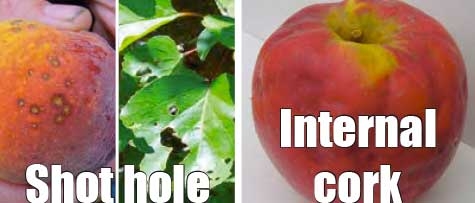Wet conditions in late winter to early spring can activate shot hole spores that have remained dormant in bud scales and twig lesions during the previous season.
Both fruit and leaves can be affected.
Infection requires at least 24 hours of continuous wetness and spores can germinate in temperatures as low as 1C. Rain during budswell helps to spread the disease.
Non-pesticide management.
A fungicide program is usually necessary to control shot hole but a number of other measures can help management.
Be careful that irrigation does not wet the leaves.
Where practical, prune infected wood and burn the prunings.
Hastening leaf fall will reduce the amount of inoculum that builds up during autumn.
Internal cork
Often known as corky pit, internal cork is a physiological disorder usually caused by low soil boron level, heavy liming, heavy crops and drought.
It causes fruit stunting and distortion in both apples and pears.
Cork disorders can be rectified by application of soluble boron compounds, both foliar and soil dressing.
As a soil dressing, apply in winter or early spring every fourth or fifth year, or when symptoms appear. Soil analysis is recommended on a 3-year basis.
Download the Orchard plant protection guide
See this article in Tree Fruit July 2019




















